Linux内核驱动编程
2015-02-12
驱动程序基础的东西这儿就不罗嗦了,百度上有更好的资料,此处我们只是注重实际用处。
下面我们开始写程序:
一、初步helloword程序
首先是来一个简单的hello。
hello.c代码:

1 /****************************** 2 3 the first program 4 5 Hello World! 6 7 ******************************/ 8 9 #include <linux/module.h> 10 11 #include <linux/init.h> 12 13 14 15 static int hello_init(void) 16 17 { 18 19 printk("<0>\nHello, world!\n\n"); 20 21 return 0; 22 23 } 24 25 26 27 static void hello_exit(void) 28 29 { 30 31 printk("<0>\nGoodbye,world \n\n"); 32 33 } 34 35 36 37 module_init(hello_init); 38 39 module_exit(hello_exit); 40 41 MODULE_LICENSE("Dual BSD/GPL"); //Any version of public GNU license
Make代码:

1 ifeq ($(KERNELRELEASE),) 2 3 KERNELDIR ?= /home/study/system/linux-2.6.31 4 5 PWD := $(shell pwd) 6 7 modules: 8 9 $(MAKE) -C $(KERNELDIR) M=$(PWD) modules 10 11 modules_install: 12 13 $(MAKE) -C $(KERNELDIR) M=$(PWD) modules_install 14 15 clean: 16 17 rm -rf *.o *~ core .depend *.cmd *.ko *.mod.c .tmp_versions *.markers *.order *.symvers 18 19 20 21 else 22 23 obj-m := hello.o 24 25 endif
注意:
①:Makefile中的KERNELDIR ,这个linux源代码的版本是和你的开发板的一模一样,必须修改,否侧或有错误
②:该应用程序必须在开发板上运行,千万注意别再服务器操作系统使用,否则存在破坏系统的危险。
接下来就是,编译->加载,使用以下命令
1 make CROSS_COMPILE=arm-none-linux-gnueabi- 2 3 //此处为修改为你操作系统上的gcc 交叉编译 4 5 insmod hello.ko 6 7 //加载模块,此时屏幕上会打印,hello,world 8 9 rmmod hello.ko 10 11 //卸载模块,同样会打印 goodsbye world
接下来我们对其进行改进
二、改进helloword程序,增加输入模块参数
我们在代码中增加以下代码:
1 static char *name = "LoverXue"; 2 3 static int age = 1; 4 5 6 7 module_param(name,charp,S_IRUGO); 8 9 module_param(age,int,S_IRUGO);
编译后,加载时,输入以下命令
make CROSS_COMPILE=arm-none-linux-gnueabi-
insmod hello.ko name="lihaiyan" age=20
结果如下:

附上源代码如下:
hello.c代码:

1 /****************************** 2 3 the first program 4 5 Hello World! 6 7 ******************************/ 8 9 10 11 #include <linux/module.h> 12 13 #include <linux/init.h> 14 15 16 17 //module param list 18 19 static char *name = "LoverXue"; 20 21 static int age = 1; 22 23 24 25 static int hello_init(void) 26 27 { 28 29 printk("<0>\nHello, %s\nI know you age is%d\n\n",name,age); 30 31 return 0; 32 33 } 34 35 36 37 static void hello_exit(void) 38 39 { 40 41 printk("<0>\nGoodbye,%s\n\n",name); 42 43 } 44 45 46 47 module_init(hello_init); 48 49 module_exit(hello_exit); 50 51 MODULE_LICENSE("Dual BSD/GPL"); //Any version of public GNU license 52 53 54 55 module_param(name,charp,S_IRUGO); 56 57 module_param(age,int,S_IRUGO);
三、改进helloword程序,增加模块之间的依赖
此时,我们的目的是:写两个模块,模块二调用模块一中的函数。
先附上代码,我们看着代码来讲解:
模块一:包含 add_sub.c add_sub.h Makefile 三个文件
add_sub.h

1 #ifndef _ADD_SUB_H_ 2 3 #define _ADD_SUB_H_ 4 5 long add_integer(long a,long b);//function add 6 7 long sub_integer(long a,long b);//function sub 8 9 #endif
add_sub.h 中定义声明了模块二中要调用的函数,函数具体实现,看add_sub.c
add_sub.c

1 /************************************* 2 3 add_sub function 4 5 *************************************/ 6 7 #include <linux/init.h> 8 9 #include <linux/module.h> 10 11 12 13 #include "add_sub.h" //包含函数声明的头文件 14 15 16 17 //returen sum of the two //实现函数 18 19 long add_integer(long a,long b) 20 21 { 22 23 return a+b; 24 25 } 26 27 28 29 //returen subtraction of the two 30 31 long sub_integer(long a,long b) 32 33 { 34 35 return a-b; 36 37 } 38 39 //为了让其他模块可以调用此函数, 40 41 //必须用EXPORT_SYMBOL将函数导出到内核 42 43 //export the function 44 45 EXPORT_SYMBOL(add_integer); / 46 47 EXPORT_SYMBOL(sub_integer); 48 49 50 51 MODULE_LICENSE("Dual BSD/GPL");
Makefile代码:

1 ifeq ($(KERNELRELEASE),) 2 3 KERNELDIR ?= /home/study/system/linux-2.6.31 4 5 PWD := $(shell pwd) 6 7 ################################################# 8 9 PRINT_INC = $(PWD)/ 10 11 EXTRA_CFLAGS += -I $(PRINT_INC) 12 13 ################################################# 14 15 modules: 16 17 $(MAKE) -C $(KERNELDIR) M=$(PWD) modules 18 19 modules_install: 20 21 $(MAKE) -C $(KERNELDIR) M=$(PWD) modules_install 22 23 clean: 24 25 rm -rf *.o *~ core .depend *.cmd *.ko *.mod.c .tmp_versions *.markers *.order *.symvers 26 27 28 29 else 30 31 obj-m := add_sub.o 32 33 endif
修改前面的代码,必须增加#号内的代码。
此时,我们模块一全部写完。
make 编译。
模块二:包含hello.c Makefile
hello.c代码:

1 /****************************** 2 3 the first program 4 Hello World! 5 ******************************/ 6 #include <linux/module.h> 7 #include <linux/init.h> 8 9 //extern module 10 #include "./add/add_sub.h" //包含头文件 11 12 //module param list 13 static char *name = "LoverXue"; 14 static int age = 20; 15 static long num1 = 1; 16 static long num2 = 0; 17 static short flag = 1; 18 19 static int hello_init(void) 20 { 21 printk("<0>\nHello, %s\nI know you age is%d\n\n",name,age); 22 if(flag == 1 ){ 23 printk("<0>sum of two %ld + %ld = %ld \n", num1,num2,add_integer(num1,num2)); 24 25 }else{ 26 printk("<0>subtraction of two %ld - %ld = %ld \n", num1,num2,sub_integer(num1,num2)); 27 } 28 return 0; 29 } 30 31 static void hello_exit(void) 32 { 33 printk("<0>\nGoodbye,%s\n\n",name); 34 } 35 36 module_init(hello_init); 37 module_exit(hello_exit); 38 MODULE_LICENSE("Dual BSD/GPL"); //Any version of public GNU license 39 MODULE_VERSION("V1.0"); 40 41 module_param(name,charp,S_IRUGO); 42 module_param(age,int,S_IRUGO); 43 module_param(num1,long,S_IRUGO); 44 module_param(num2,long,S_IRUGO); 45 module_param(flag,short,S_IRUGO);
Makefile文件代码:

1 ifeq ($(KERNELRELEASE),) 2 3 KERNELDIR ?= /home/study/system/linux-2.6.31 4 5 PWD := $(shell pwd) 6 7 ########################################################## 8 9 export-objs := /home/study/EasyARM-iMX257/module_study/02_add/add/add_sub.o 10 11 SYMBOL_INC = $(obj)/ 12 13 SYMBOL_INC += /home/study/EasyARM-iMX257/module_study/02_add/add 14 15 EXTRA_CFLAGS += -I $(SYMBOL_INC) 16 17 KBUILD_EXTRA_SYMBOLS = /home/study/EasyARM-iMX257/module_study/02_add/add/Module.symvers 18 19 ######################################################### 20 21 modules: 22 23 $(MAKE) -C $(KERNELDIR) M=$(PWD) modules 24 25 modules_install: 26 27 $(MAKE) -C $(KERNELDIR) M=$(PWD) modules_install 28 29 clean: 30 31 rm -rf *.o *~ core .depend *.cmd *.ko *.mod.c .tmp_versions *.markers *.order *.symvers 32 33 else 34 35 obj-m := hello.o 36 37 endif
KBUILD_EXTRA_SYMBOLS的意思就是包含我们要调用的模块的Module.symvers,
此处最好使用绝对路径。
编译,
如果编译出错,如图所示。

解决方法是;先编译模块一,然后将模块一的Module.symvers拷贝到我们的模块二的目录下,再编译模块二。
如图所示就不会再出这样的错误了。
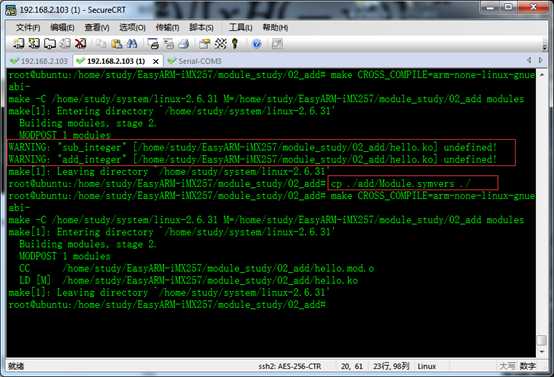
加载模块
接着就是在开发板中加载模块
insmod ./add/add_sub.ko insmod hello.ko num1=50 num2=20 flag=0
结果如下:
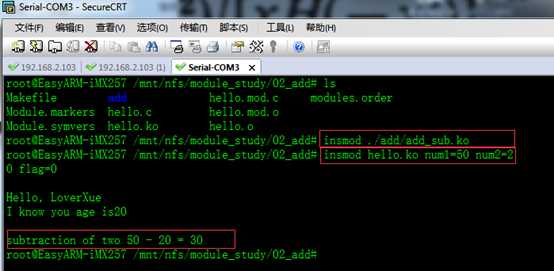
四、将驱动使用静态编译入内核
接下来,我们来将刚刚写的代码使用静态编译,加入内核
mkdir add_sub_Kconfig


Makefile代码
#drivers/add_sub_Kconfig/Makefile # Makefile for the ADD_SUB core. # obj-$(CONFIG_ADD_SUB) := add_sub.o obj-$(CONFIG_TEST) := hello.o
Kconfig代码如下:
#drivers/add_sub_Kconfig/Kconfig menu "ADD_SUB" #main menu //增加主菜单 comment "ADD_SUB" //增加子菜单 config CONFIG_ADD_SUB #children menu, add the add_sub module boolean "ADD_SUB support" default y #children menu ,add the test menu config CONFIG_TEST tristate "ADD_SUB test support" depends on CONFIG_ADD_SUB #Depends on the config CONFIG_ADD_SUB default y endmenu
Makefile中增加:
obj-$(ADD_SUB) += add_sub_Kconfig/
将上面我们自己写的makefile文件包含进来:

Kconfig中末尾增加以下代码:
将上面我们自己写的Kconfig文件包含进来
source "drivers/add_sub_Kconfig/Kconfig" source "drivers/test//Kconfig"

(实验证明只对,只对drivers/Kconfig中修改内容无效,drivers/Kconfig中修改内容无效,还要对arch/arm/Kconfig进行修改,很重要的一步,很多资料上都遗漏了这一步)
在Kconfig中加入代码:
source "drivers/add_sub_Kconfig/Kconfig"
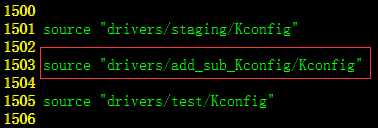
在内核的根目录下执行,make menuconfig 如图所示:
进入Device Drivers 目录

在最后面,我们看到了,我们自定义的模块:ADD_SUB模块
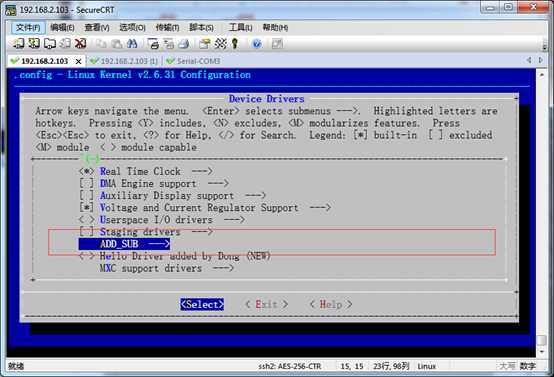
进入ADD_SUB,我们会看到我们写的两个模块全都默认选中了
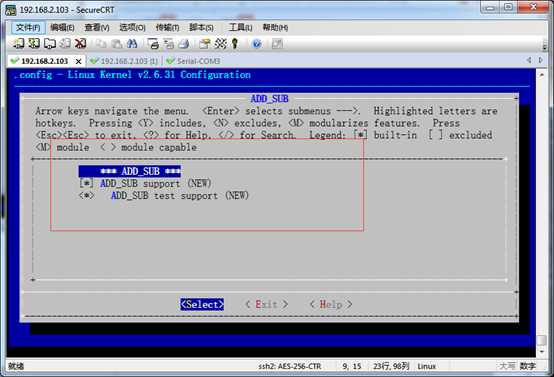
此时,我们再次编译内核,就会把我们的模板使用静态编译进内核。
原文:http://www.cnblogs.com/lihaiyan/p/4288907.html